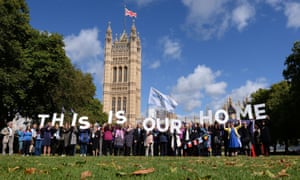Migration experts have warned that the post-Brexit system for registering EU citizens living in the UK could become a new “Windrush scandal” as the scheme to register an estimated 3.5 million EU citizens living in the UK begins.
From Monday, the third phase of testing will open to EU residents in the UK, who will be able to register for the new post-Brexit “settled status”. The Home Office is extending its live trial to all EU citizens who hold a valid passport and any non-EU citizen family members who hold a valid biometric residence card.
Critics have warned that thousands could be left without legal status to remain in the UK if applications are not processed quickly and effectively.
Maike Bohn, founder of the3million which campaigns for EU citizens in the UK to retain their existing rights after
Brexit, warned trust in the government was low.
“The Windrush people trusted the Home Office and many of them got deported because they were citizens but couldn’t prove it,” she said.
The expansion of the scheme follows two “private” test phases. The second phase saw 29,987 applications submitted with 27,211 decisions made. Of those, no cases were refused. However,
the second phase was open to 250,000 people in selected universities, health and social care bodies.
The Home Office said 70% of applicants had been granted settled status with the remaining 30% granted pre-settled status, which is given to those who have been in the country for fewer than five years. There was positive feedback from 77% of applicants.
The immigration minister, Caroline Nokes, said: “From the very beginning we have been clear that securing the rights of EU citizens living in the UK is our priority.
“The report into the second private test phase of the EU settlement scheme shows clearly that we are well on track to deliver a system that will make it easy and straightforward for EU citizens to obtain status once we have left the EU.
“We are now in a position to proceed with the wider public testing of the scheme, which will provide us with further valuable insight before the full launch of the system by the end of March. We are grateful to those individuals and organisations that have participated in the testing so far.”
Politicians, migrant thinktanks and charities have warned the UK could face “another Windrush” if the settled status scheme fails.
Chai Patel, legal policy director at the joint council for welfare of immigrants, said: “EU citizens who do not pay to apply for settled status by 2021 will lose their right to live in the UK and become undocumented.
“This is a major obstacle in the way of achieving the government’s promise that every EU national currently in the UK will be welcome after Brexit. By charging a fee and by setting a time limit for applications the government is making it certain that some people will not get settled status.
“And with 3 million to 4 million people needing to register, that means creating tens or hundreds of thousands of undocumented migrants overnight. The poor, the elderly, [and] those with illnesses or disabilities will be particularly affected as the government is failing to set aside enough resources to help them.
“We therefore urge the government to do everything in its power to make sure everyone’s rights are protected after Brexit. Instead of creating a system that defaults to removing rights if a person does not pay for an application, the government should today grant a free and permanent legal right to stay to all EU nationals resident in the UK.
“The Home Office should then provide a free and simple process by which people can obtain documents proving that right.”
Jill Rutter, director of strategy for British Future and co-author of the report, said: “The Home Office must invest in getting the EU settlement scheme right from the start. Failure to do so could cause massive problems in years to come, on a far bigger scale than the ‘Windrush scandal’.
“The application system should work simply and efficiently for the vast majority of EU citizens. But there will always be more complex cases where people find it harder to navigate the system or to prove their residency – and the sheer scale of this task means even a low rate of failure equates to tens of thousands of people.
“The Home Office needs to make sure that people hear about the scheme, that it works well and that errors are remedied quickly when they are made. It must also overcome a legacy of mistrust created by the previous permanent residency scheme.
“This is an important test for the Home Office. The stakes are high. Get it right and the UK sends a strong message that EU citizens are welcome and the government is in control. Get it wrong and the consequences are dire.”
Ed Davey, Liberal Democrat home affairs spokesman, said: “No one seriously believes that the Home Office will be able to grant settled status to everyone who’s eligible within two years. Thousands will be left effectively undocumented and subject to Theresa May’s hostile environment.
“Liberal Democrats demand better for the Europeans who’ve made their lives here and contribute so much to our economy, our public services and our society. They must not become the victims of a new
Windrush scandal.”
The Guardian 21 Jan 2019






